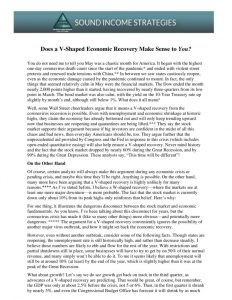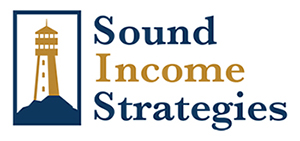Does a V-Shaped Economic Recovery Make Sense to You?
 You do not need me to tell you May was a chaotic month for America. It began with the highest one-day coronavirus death count since the start of the pandemic* and ended with violent street protests and renewed trade tensions with China.** In between we saw states cautiously reopen, even as the economic damage caused by the pandemic continued to mount. In fact, the only things that seemed relatively calm in May were the financial markets. The Dow ended the month nearly 2,000 points higher than it started, having recovered by nearly three-quarters from its low point in March. The bond market was also calm, with the yield on the 10-Year Treasury rate up slightly by month’s end, although still below 1%. What does it all mean?
You do not need me to tell you May was a chaotic month for America. It began with the highest one-day coronavirus death count since the start of the pandemic* and ended with violent street protests and renewed trade tensions with China.** In between we saw states cautiously reopen, even as the economic damage caused by the pandemic continued to mount. In fact, the only things that seemed relatively calm in May were the financial markets. The Dow ended the month nearly 2,000 points higher than it started, having recovered by nearly three-quarters from its low point in March. The bond market was also calm, with the yield on the 10-Year Treasury rate up slightly by month’s end, although still below 1%. What does it all mean?
Well, some Wall Street cheerleaders argue that it means a V-shaped recovery from the coronavirus recession is possible. Even with unemployment and economic shrinkage at historic highs, they claim the economy has already bottomed out and will only keep trending upward now that businesses are reopening and quarantines are being lifted.*** They say the stock market supports their argument because if big investors are confident in the midst of all this chaos and bad news, then everyday Americans should be, too. They argue further that the unprecedented aid provided by Congress and the Fed in response to this crisis (which includes open-ended quantitative easing) will also help ensure a V-shaped recovery. Never mind history and the fact that the stock market dropped by nearly 60% during the Great Recession, and by 90% during the Great Depression. These analysts say, “This time will be different”!
On the Other Hand
Of course, certain analysts will always make this argument during any economic crisis or pending crisis, and maybe this time they’ll be right. Anything is possible. On the other hand, many more have been arguing that a V-shaped recovery is highly unlikely for many reasons.**** As I’ve stated before, I believe a W-shaped recovery—where the markets see at least one more major downturn—is more probable. The fact that the stock market is currently down only about 10% from its peak highs only reinforces that belief. Here’s why:
For one thing, it illustrates the dangerous disconnect between the stock market and economic fundamentals. As you know, I’ve been talking about this disconnect for years, but the coronavirus crisis has made it (like so many other things) more obvious—and potentially more dangerous. ***** The argument for a V-shaped recovery conveniently ignores the possibility of another major virus outbreak, and how it might set back the economic recovery.
However, even without another outbreak, consider some of the following facts. Though states are reopening, the unemployment rate is still historically high, and rather than decrease steadily, I believe those numbers are likely to ebb and flow for the rest of the year. With restrictions and partial shutdowns still in place, some businesses will have to try to get by on 50% of their normal revenue, and many simply won’t be able to do it. To me it seems likely that unemployment will still be at around 10% (at least) by the end of the year, which is slightly higher than it was at the peak of the Great Recession.
What about growth? Let’s say we do see growth get back on track in the third quarter, as advocates of a V-shaped recovery are predicting. That would be great, of course, but remember, the GDP was only at about 2.5% before the crisis, not 5 or 6%. Then, in the first quarter it shrank by nearly 5%, and even the Congressional Budget Office has forecast it will shrink by as much
as 30 to 40% in the second quarter.****** So, how will all of that balance out by the end of the year? Mathematically speaking, a GDP of -10% for 2020 would probably be a best-case scenario!
Common Sense
So, the question is: does any of that sound like it should justify steadily rising stock prices? Does it sound like the makings of a V-shaped recovery? Not to me, and not to most global fund managers either, of whom only 1 in 10 believe a V-shaped recovery is possible.******* I concur, and continue to believe that the stock market will experience at least one more major pullback before it truly starts to recover. It may not be as precipitous as the first drop, but it will return the market to bear territory and possibly test its low point from March. I also believe the drop may be more gradual (two days up, three days down, two more up, etc.) and more segmented. In March, there was a flight to cash, and everything dropped: stocks, bonds, and bond-like instruments. This time, investors and advisors will have had time to analyze what should and shouldn’t be sold, meaning riskier holdings may drop more than conservative ones.
In the midst of all this disconnection and uncertainty, income-based investors can continue to take comfort in the knowledge that their portfolios are, generally, better protected from loss and shrinkage than those of growth-based investors, as I’ve explained in previous newsletters.
If, on the other hand, you still have significant investments elsewhere in common stock or stock mutual funds (or you have friends or family who do), you might want to re-read this newsletter and ask yourself: “What do I think? Do I hold with the analysts who claim ‘This time will be different?’ Do I believe the stock market makes sense right now considering all the economic data, and that we’re on our way to a V-shaped recovery? Or do I believe another pullback sounds more likely?” Those are crucial questions because, as I always stress, smart investing isn’t just about numbers and textbook formulas. It’s also about plain old-fashioned common sense!
- *“Stocks Slightly Higher Amid Unrest, US-China Tensions,” Yahoo Finance, June 1, 2020
- **“The US Just Reported it’s Deadliest Day for Coronavirus Patients, CNBC, May 2, 2020
- ***“US Economy to See V-Shaped Recovery: Morgan Stanley,” Fox Business, May 11, 2020
- ****“A V-Shaped Recovery is ‘Off the Table,’ Fed’s Kashkari Says,” MarketWatch, May 14, 2020
- *****“A Dangerous Gap: The Market vs. The Real Economy,” The Economist, May 7, 2020
- ******“What is a V-Shaped Economic Recovery & How Likely is It,” MercuryNews.com, May 27, 2020
- *******“Just One in Ten Fund Managers Expect a V-Shaped Recovery,” Financial Times, May 2020
